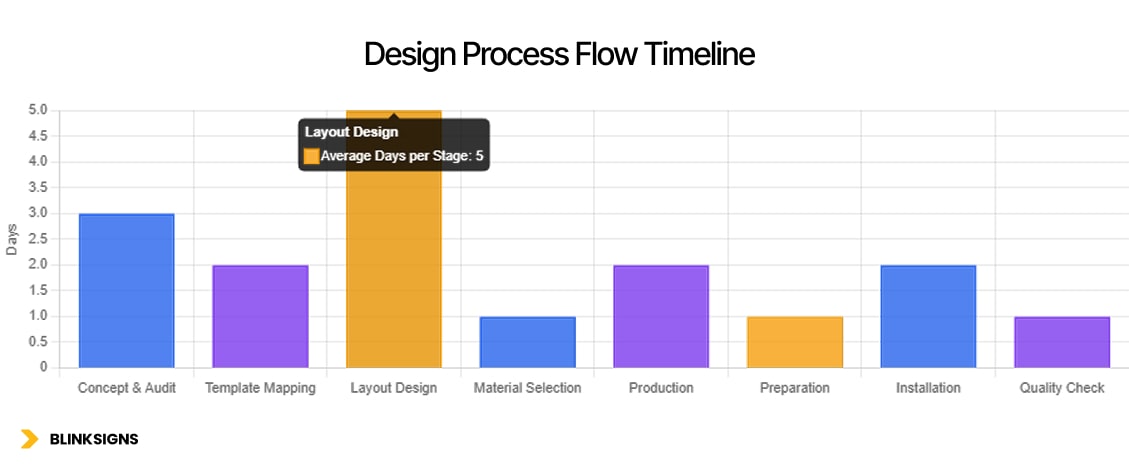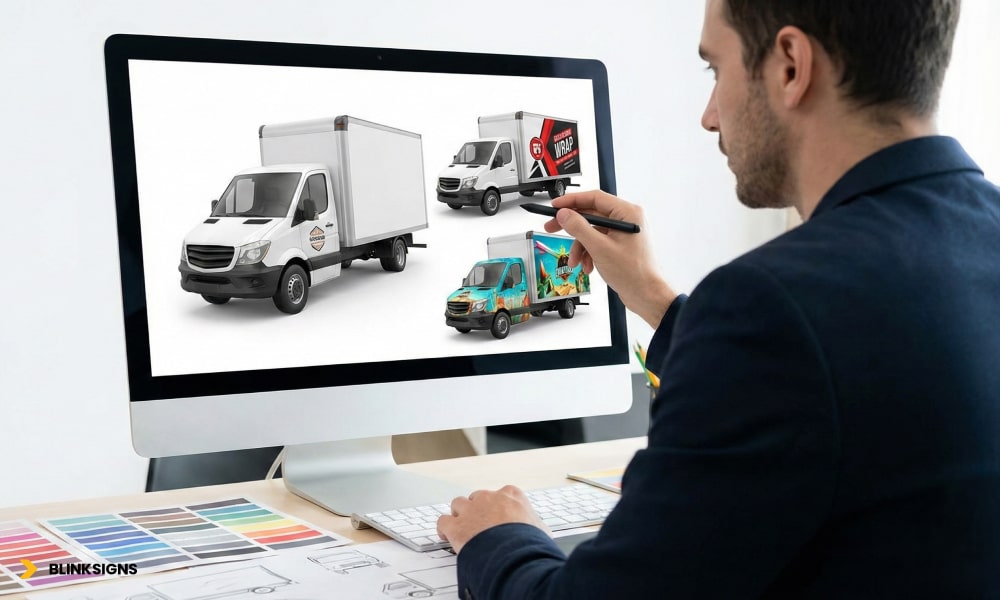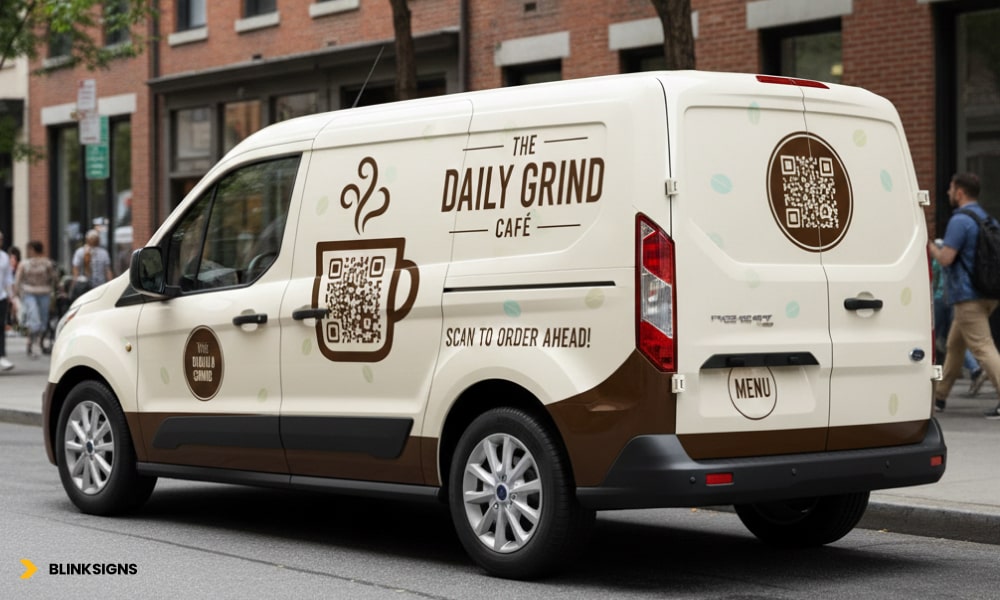
Vehicle Wrap Design Process and 2026 Trends
A plain vehicle has no story. It drives from point to point without presence or identity. A wrapped vehicle tells a very different story. Its colors appear instantly recognizable in a crowd. Its message travels through busy streets, highways, markets, and neighborhoods. People notice it even when they are not trying to.
In a world where attention is a valuable commodity, a wrapped vehicle becomes a moving brand experience that continues to work every hour of the day.
Many businesses consider vehicle wraps only when they need a quick advertising boost. What they often miss is the power that a well-designed wrap brings to long-term brand recognition.
A vehicle can generate thousands of impressions in a single day, particularly in busy commercial areas. Vehicle wraps carry brand identity into locations that digital ads cannot reach. It reinforces trust through constant visibility.
As we move into 2026, vehicle wraps are no longer just vinyl graphics; they have evolved into a more comprehensive and sophisticated form of advertising. They are an essential layer of brand communication that blends design, technology, sustainability, and psychology.
BlinkSigns has helped transform vehicles for service companies, retailers, logistics brands, healthcare fleets, and regional enterprises. Through every project, one thing remains clear. A strong vehicle wrap begins long before installation and delivers value long after it hits the road.
What is a Vehicle Wrap and Why It Matters
A vehicle wrap is a high-performance vinyl film that covers all or selected parts of a vehicle. It can include a full wrap, which covers the entire exterior, or a partial wrap that highlights specific panels.
Today’s wraps utilize durable vinyl wrap materials, including cast vinyl, calendered vinyl, and specialized laminates, that resist UV exposure, heat, abrasion, and various weather conditions.
Vehicle wraps matter because they create mobile advertising that travels with your brand, allowing it to reach a wider audience. Instead of relying on fixed billboards, companies gain visibility through everyday routes. A single well-positioned wrap can generate thousands of daily impressions in dense urban areas.
Research on the vehicle wrap market indicates a steady increase through 2033, driven by rising demand for cost-effective advertising, sustainable materials, and digital integration.
Beyond visibility, wraps support a strong brand identity. They unify fleets, strengthen recognition, and give businesses a professional look that customers trust. A wrap also protects the factory paint, which helps maintain the vehicle’s resale value. For multi-location businesses, wraps ensure consistency across different cities, climates, and vehicle types.
In 2026, businesses are investing more in vehicle branding due to tighter marketing budgets and the rising effectiveness of physical brand presence. A wrapped vehicle becomes a moving touchpoint that feels real, tangible, and memorable in ways digital advertising cannot replicate.
The Complete Vehicle Wrap Design Process

Design Process Flow Timeline
Competitors often summarize the vehicle wrap process in a few short lines. In reality, a high-impact wrap involves many stages, each designed to protect quality, brand compliance, and long-term performance. A true street-ready wrap follows a structured sequence that merges design, engineering, materials, and installation accuracy.
Below is the complete process followed by professional wrap teams, such as BlinkSigns.
1. Concept and Brand Audit
The journey starts with a clear understanding of the brand. Colors, typography, values, personality, and messaging all contribute to shaping the wrap’s look and feel. A strong wrap begins with a brand audit that identifies:
- Core brand elements
- Target audience and geographic exposure
- Competitive landscape
- Required messaging hierarchy
- Fleet standards for multi-vehicle consistency
This stage ensures that the wrap reflects identity, not decoration.
2. Vehicle Template Mapping

Vehicle Wrap branding Template Mapping
No two vehicles are the same. Every model has its own curves, handles, panels, rivets, and body lines. Designers use manufacturer-approved vehicle templates to map accurate dimensions. This prevents artwork distortion and ensures logos do not stretch across bends or disappear around door gaps.
During this stage, designers examine:
- Wheel arches
- Door handles
- Rear curves
- Window placement
- Hood and bumper angles
- Panel seams
Accurate templates eliminate costly reprints and maintain clean branding once installed.
3. Layout and Design Development
This is where your brand becomes a moving experience. Skilled designers focus on readability, contrast, and visual hierarchy. They ensure that key information, such as the logo, tagline, and contact details, remains visible whether the vehicle is in motion or stationary.
Key design principles include:
- High contrast color combinations for city traffic
- Proper font sizing for visibility at 30 to 50 mph
- Placement of essential elements on the largest flat surfaces
- Avoiding heavy detail near extreme curves
- Supporting fleet branding consistency across vehicle types
Designers also consider local conditions. A vehicle wrapped for Karachi’s dense roads needs bold and easily readable graphics. A car in Dallas or Cleveland may require contrast for long highways and high-speed visibility.
4. Material Selection
Choosing the right vinyl wrap materials determines the lifespan of the wrap. This stage includes evaluating:
- Cast vinyl for premium durability
- Calendered vinyl for budget-conscious wraps
- Laminates for UV and scratch protection
- Eco-friendly wrap materials for sustainability goals
- Specialty films such as reflective, chrome, textured, or matte gloss hybrids
Using the wrong material can shorten wrap life or cause fading when exposed to intense sunlight. BlinkSigns helps clients select stable materials that handle climate, road conditions, and annual mileage.
5. Production and Print Calibration
Once the design is approved, the wrap enters production. This includes:
- Color calibration for brand correctness
- Panel-by-panel printing to prevent alignment issues
- Laminating for durability
- Cutting panels based on the vehicle template
- Quality testing to catch imperfections
This step determines how the wrap will look in real lighting conditions. Accurate color output ensures the brand appears consistent across fleets and locations.
6. Pre-Installation Preparation
A high-quality installation cannot begin until the vehicle is fully prepared. Proper prep prevents peeling, bubbling, or improper adhesion.
Preparation includes:
- Thorough cleaning
- Degreasing
- Dust removal
- Drying
- Confirming the appropriate temperature
A clean surface ensures strong adhesive bonding and long-lasting durability.
7. Installation and Fit

Commercial Vehicle Wrap Installation and Fitting
Installation brings the wrap to life. Professional installers apply heat to conform the vinyl into curves, recesses, and complex edges. Precision matters. Misaligned panels affect readability and brand confidence.
Installers focus on:
- Stretch control
- Bubble and crease removal
- Seam alignment
- Door gap trimming
- Edge sealing
A flawless installation is the difference between a premium wrap and a short-lived one.
8. Final Quality Check and Street Ready Inspection
Before the vehicle is released, it undergoes a full inspection. This ensures safety, visibility, and long-term performance.
The checklist includes:
- Bubble detection
- Panel alignment
- Seam accuracy
- Door function testing
- Road visibility test
- Brand element verification
Only after these checks is the vehicle considered street-ready.
2026 Vehicle Wrap Trends That Shape the Future of Mobile Branding
The vehicle wrap industry is entering a new phase where creativity and innovation converge. Brands want designs that move beyond traditional graphics. They want wraps that spark curiosity, encourage interaction, and stand out in fast-moving environments.
The upcoming year brings new technologies, sustainable materials, and design approaches that help companies stay memorable on the road.
1. AR and Interactive Wrap Experiences
Augmented reality is making vehicle branding more engaging. When users scan a specific part of the wrap with their phone, digital content appears. The wrap can include product animations, promotional videos, store locators, menus, or service details. AR-enabled wraps increase customer interaction and turn vehicles into mobile content platforms.
Organizations are using AR to:
- Explain services visually
- Launch seasonal campaigns
- Drive traffic to e-commerce pages.
- Create memorable brand moments in a busy market.
2. QR-Driven Customer Journeys

QR-Driven Customer Journeys on Commercial Vehicle Wrap
QR codes are becoming a key branding element. They connect offline audiences to digital funnels. In 2026, QR codes are designed more strategically with creative frames, color matching, and placement that feels integrated rather than added.
QR codes help businesses:
- Capture leads
- Direct users to offers
- Promote app downloads
- Track engagement by vehicle location
3. Eco-Friendly Vinyl Films
Sustainability is influencing design and material choices. Brands want wraps that align with environmentally conscious values. New eco-friendly wrap materials include PVC-free films, recyclable substrates, and low-VOC inks. These options reduce waste and create opportunities for green certifications.
Drivers appreciate the brand more when sustainability is reflected in visible touchpoints, such as fleet vehicles.
4. Reflective Films and Safety-Focused Designs
Reflective and visibility-enhancing materials are gaining traction. These wraps enhance nighttime visibility, contributing to improved road safety. Logistics companies, emergency services, and delivery fleets often prefer reflective accents for enhanced on-road visibility.
5. Matte Gloss Hybrid Finishes
2026 introduces hybrid finishes that combine matte and gloss textures, not for a luxury appearance, but for practical branding contrast. These finishes improve legibility in bright sunlight and reduce glare.
6. Micro Patterns and Bold Typography
Strong typography is becoming a core design element. Larger letterforms, high-contrast colors, and bold patterns help brands stand out in the crowd. Micro patterns create visual depth without overwhelming the viewer. These patterns maintain clarity even at distances where small details typically fade away.
7. AI-Supported Layout Planning
Designers are utilizing AI-enhanced tools to visualize wraps in 3D environments before printing. This improves panel mapping accuracy, avoids distortion, and predicts how the wrap will appear in real street conditions.
Fleet Branding for Multi-Vehicle and Multi-Site Enterprises
Fleet branding is powerful because it turns a group of vehicles into a unified brand experience. However, multi-vehicle and multi-site rollouts introduce challenges that most businesses underestimate.
BlinkSigns helps organizations overcome these challenges by offering strategic planning, brand consistency systems, and centralized control.
1. Standardized Design Kits for Various Vehicle Types
A fleet often includes:
- Vans
- Pickup trucks
- Sedans
- Box trucks
- Delivery bikes
- SUVs
Each vehicle needs a consistent design adapted to its shape. BlinkSigns creates standardized wrap kits that keep brand identity aligned across all form factors.
2. Multi-City and Multi-State Brand Compliance
Different regions have varying regulations for commercial vehicle branding. Some areas limit window coverage. Others require reflective accents. A strong rollout plan considers:
- Regional advertising rules
- Local installation standards
- Material selection based on climate
This protects brand accuracy and ensures smooth approvals.
3. Climate-Based Material Requirements
Hot regions need UV-stable laminates. Cold climates require flexible adhesives that withstand temperature drops. Coastal cities require wraps that are resistant to moisture and salt exposure. Materials chosen for Miami may differ from materials used in Chicago or Dallas.
4. Fleet Tracking and Wrap Lifecycle Logs
Enterprises track each vehicle’s wrap condition, installation date, maintenance history, and upcoming replacement cycle. This improves planning and prevents brand inconsistency.
5. Logistics and Coordination
Large fleets require:
- Coordinated installation schedules
- On-site installation teams
- Shipping of printed panels
- Quality control between sites
BlinkSigns manages multi-location production and installation to ensure every vehicle matches the original approved design.
Wrap Durability, Maintenance, and Lifecycle Management

Wrap Durability, Maintenance, and Lifecycle Management-min
A vehicle wrap can last several years if maintained properly. Businesses often assume that installation is the final step, but it is actually maintenance that ultimately determines long-term success.
1. Cleaning Protocols
Regular cleaning prevents dirt buildup and protects the laminate. The vehicle should be washed with mild soap and soft cloths. Pressure washing should be avoided unless done at low pressure with proper angles.
2. UV Protection and Surface Care
Vehicles parked outside for extended periods require UV-resistant materials to prevent fading. Sun exposure affects wraps differently depending on the local climate.
3. Laminate Care
Laminates act as a protective layer. Over time, they may require reapplication to preserve the sheen and color vibrancy.
4. Edge Lifting Prevention
Edges are the first areas to show wear. Proper care prevents lifting, which can lead to water intrusion and early failure.
5. Wrap Removal and Refresh Strategy
Removal should be done professionally to avoid paint damage. Businesses often use removal cycles to launch updated branding.
Vehicle Wrap ROI Breakdown for 2026

Vehicle Wraps vs Other Media – BlinkSigns Cost Efficiency Chart
Vehicle wraps deliver some of the most cost-effective impressions in outdoor advertising. A well-wrapped vehicle can generate thousands of daily impressions, especially in cities with dense traffic.
Below is a marketing comparison table that highlights the value of vehicle wraps.
Marketing Cost Comparison Table
| Advertising Medium | Average CPM (Cost per 1,000 impressions) | Lifespan | Visibility Level | Ideal Use Case |
| Vehicle Wrap | Very low | 3 to 5 years | High in city and highway traffic | Multi-location businesses, fleets, and local service brands |
| Billboard | Higher | Monthly rental | High but stationary | Brand awareness, large campaigns |
| Digital Ads | Medium to high | Continuous investment | Short exposure time | Lead generation and remarketing |
| Transit Ads | Medium | Weeks or months | High in busy routes | Urban audience targeting |
| Print Ads | High | One-time | Limited | Promotions and corporate branding |
Vehicle wraps provide long visibility for a single upfront investment. This makes them ideal for brands with vehicles on the road throughout the day.
FAQs
What is a vehicle wrap?
A vehicle wrap is a vinyl film applied to the exterior surface of a vehicle. It displays branded graphics, colors, and messaging that turn the car into a moving advertisement. Wraps protect factory paint and create a strong visual identity for businesses.
How long does a vehicle wrap last?
Most wraps last three to five years, depending on factors such as climate, sun exposure, driving conditions, and maintenance. High-quality materials and proper cleaning can extend the lifespan.
What is the difference between a full wrap and a partial wrap?
A full wrap covers the entire vehicle, including doors, fenders, and rear panels. A partial wrap highlights selected areas such as the sides or back. Full wraps provide the most substantial brand impact. Partial wraps offer a lower budget alternative that still delivers visual visibility.
How does the design process work?
The process includes concept creation, brand audit, vehicle template mapping, layout design, material selection, print production, installation, and a final street-ready inspection. Each stage ensures the design fits the vehicle accurately and performs well on the road.
How much does a vehicle wrap cost?
Costs vary based on vehicle size, material choice, design complexity, and installation time. A high-quality wrap is a long-term investment that delivers more impressions at a lower cost than many other advertising channels.
What makes a good vehicle wrap design?
Strong contrast, straightforward typography, readable logos, correct placement, and visibility at driving speeds all contribute to a high-performing wrap. A good design communicates the brand message quickly and remains legible in busy traffic.
What trends are shaping vehicle wraps in 2026?
Key trends include AR-enabled graphics, QR-linked customer experiences, eco-friendly materials, reflective visibility films, matte gloss hybrid finishes, micro patterns, and AI-supported layout planning.
Are vehicle wraps suitable for fleet branding?
Yes. Wraps are ideal for fleets across vans, SUVs, pickups, and trucks. A consistent wrap system improves recognition and projects professionalism across multiple locations.
How do vehicle wraps perform in hot or cold climates?
Wrap durability depends on the materials and laminates used. Hot climates require UV-stable films. Cold climates require flexible adhesives that remain strong during temperature fluctuations. Coastal regions benefit from moisture-resistant substrates.
How should a wrapped vehicle be cleaned?
Use mild soap, water, and soft cloths. Avoid using abrasive materials and high-pressure washing unless done at low pressure and at the correct angles. Proper cleaning prevents fading and edge lifting.
Can wraps be removed without damaging the paint?
Yes. High-quality wraps are designed to be removed safely when applied to factory paint. Professional removal prevents residue and ensures the vehicle maintains resale value.
Do wraps fade over time?
Color fading can occur when an item is exposed to prolonged sunlight. UV-resistant laminates and regular maintenance help reduce fading and preserve the wrap’s vibrancy.
How long does installation take?
Most installations take one to three days, depending on vehicle size and graphic complexity. Larger fleet rollouts are scheduled across multiple days for consistency.
Why should businesses choose vehicle wraps for advertising?
Wraps deliver low-cost impressions, high visibility, long lifespans, and constant exposure. They promote brand identity every time the vehicle moves through city streets or highways.
How does BlinkSigns support multi-site fleet branding?
BlinkSigns provides standardized design kits, climate-based material recommendations, precise template mapping, consistent print production, on-site installation coordination, and long-term wrap lifecycle management.
Getting Street Ready with BlinkSigns
A vehicle wrap becomes successful when every detail aligns with the brand’s goals. BlinkSigns guides clients through each stage, from concept and brand alignment to installation and post-wrap care.
Clients receive:
- A complete brand audit
- Professional wrap design and template mapping
- Accurate material selection
- High-quality print and lamination
- Installation by certified teams
- Final street-ready quality checks
- Fleet-wide consistency management
Brands that want reliable visibility, professional presentation, and long-term value choose BlinkSigns because they want vehicles that speak clearly and confidently wherever they go.